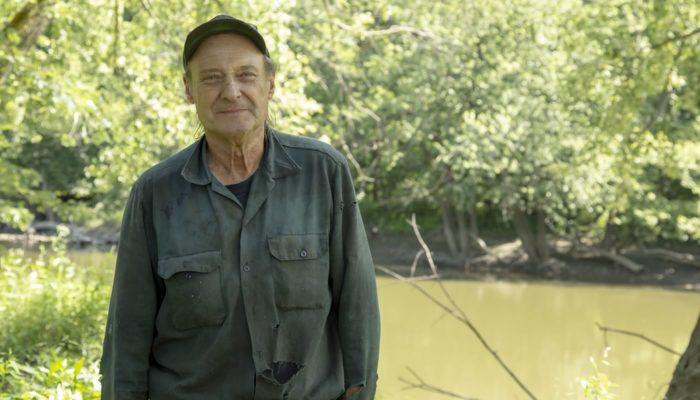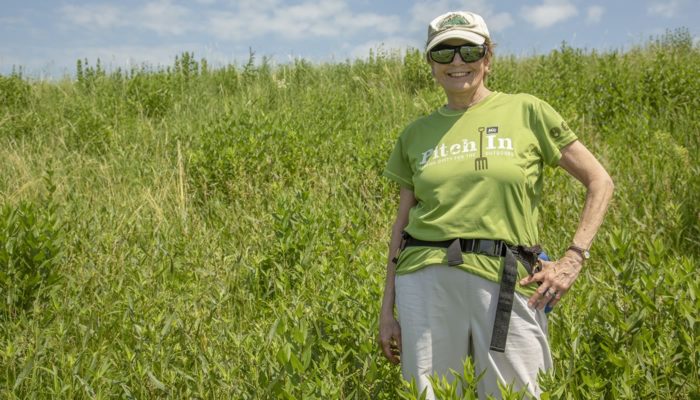The Forest Preserves boasts a large network of volunteers doing incredible work all across the County like restoring habitat, monitoring plant and animal populations, patrolling our trails, supporting special events and so much more. Though many volunteers fly solo, like Trail Watch volunteers, or work in small groups, like stewardship volunteers, each individual belongs to this larger, like-minded community of people who love nature and care for the Preserves.

John Mach
“I am a Des Plaines River Valley volunteer, and I’m also a member of the Hofmann Dam River Rats. We have been doing river restoration on the Des Plaines River since about 1996. We do a lot of work with the Illinois Department of Natural Resources (IDNR) as far as fish counts, and we also do bank plantings and river cleanups. If you look over at all the Lizard’s Tail down there, we planted all of that. It used to be bare mud. That was something that was done about 15 years ago and we’re still doing it. Cutting buckthorn is just sort of a social event.
“I have also been a fisherman on the Des Plaines River for the last 60 years. I mean, I’ll be honest and tell you that from the time I could sneak out of the house on my bicycle, I was going fishing. I can remember the river when it basically didn’t have much in it, and at times it smelled bad. You didn’t want to go anywhere near it. But I’ve seen a reversal here in the water quality, in the fish population, and the macroinvertebrate population that’s just out of sight. It’s thanks to volunteers but also the Clean Water Act that was passed in ’72. Metropolitan Water Reclamation District does a lot of work, IDNR does a lot of fish stocking and fish surveys so we have accurate counts on what’s going on. We assist with those, providing labor whenever we can. We talk to Region II Fisheries quite a bit from IDNR. Whenever they need help, we try to show up. They are short-staffed and feel the pinch like anybody else in state and local government. A little bit of free help is not bad.
“But my main focus is looking at the river quality and the turnaround we’ve seen. Our big program with our group for many years was the Hofmann Dam notching. We are the grassroots group that initiated that idea. And there were a lot of people who thought we were totally crazy, but it has worked out pretty well. We’d like to see the last two dams on the Des Plaines River get taken out, but financially or whatever, we don’t know what’s going to happen. We’re still pushing it. Since the Hoffman Dam’s been done, you see a lot more kayakers. You don’t have the danger of going over the dam and getting hurt. We’re also starting to see wading birds, as well as some predatory birds coming back. At one point it probably was a good natural flyway.
“You have to remember something. I go to various club meetings for clubs that I’m not really a member of. There are people catching 30 inch northern pike in this river within sight of where we’re standing now, alright? I know people who are driving out to Wisconsin and not coming home with anything better. And yet, this is in your back yard. Yes, it’s an urban river. It’s never going to be a trout stream. It never was a trout stream. It’s not going to have salmon in it no matter what. But, it’s a useful resource and it’s close to home. You don’t have to spend the whole day driving to get here. And the fact is, this river is getting better all the way down the length with the dam removals and all the work that’s been done. If you’re anywhere close in the Western suburbs, you’ve got a resource right outside your door. Utilize it, but take care of it.”

Jan Ahrensfeld
“My sister was the Biology major. I was a history major. When we were kids living in Palatine, we used to go to picnics and play at Deer Grove way back when there was still a lake there. My parents were actually very allergic to the outdoors, and when I look back on it now, I’m wondering how they were able to spend as much time as they did outdoors. But I was, as they say, the ‘wrinkled pea’ in the Mendelian sense where if you have four peas, one is wrinkled and three are smooth. I was the wrinkled one because I did not have allergies but my sister did, and if my parents had more children they’d probably have allergies, too.
“Later on, I moved to Chicago for many years and due to family issues, I ended up moving back to Palatine. I had a lot of friends in the city but not out here. I thought I would take advantage of the outdoors. I had been a member of Sierra Club in the city but you know, I lived in Lincoln Park and there’s the park and that’s about it. I saw an ad in the newspaper about Poplar Creek Prairie and I decided to come out and see. I was taking care of my dad at that point so the first couple of years I came irregularly, but over the years I got more and more involved in it. I didn’t come here for the science. I still can’t remember half the plants. I came for the social kind of thing and being outdoors. That’s what appealed to me. And of course, helping the environment and that kind of thing.
“Over time, we all got to know each other really well. Part of it was I was single and this group had a lot of single people so, maybe that made for more friendships. Some people here have gone on vacations together and planned all kinds of little trips. We drive each other to medical appointments. People come from all over the place, but we come together here and we always go to lunch afterwards. Now, this is another little funky thing, but you know so many other volunteer groups are just women, women, women, right? Okay. Numerous times, after the workday at different times of the year, I’ve ended up sitting at a table at Buona Beef where we have lunch, and it’s like me and five guys! Now, I mean, there aren’t very many volunteer groups where that can happen. So it’s a nice mix of people.”
Inspired by the photo blog Humans of New York, Kris DaPra and Joanna Huyck of the Volunteer Resources team will be working together to introduce you to your fellow volunteers all throughout 2019. You’ll get to know the names and faces of the people (like you) without whom the preserves could simply not exist. We hope that you’ll enjoy this ongoing project, and we look forward to interviewing YOU at an upcoming workday, on your monitoring route, during your Trail Watch patrol or anywhere else you make a difference. Thank you for being a volunteer!
